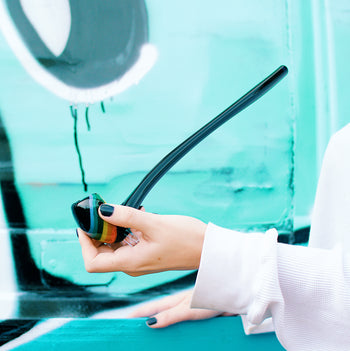The exploding industry of art glass as a functional water pipe or bong has given a breath of new life to everyone involved in the glass industry.
From the manufacturers of raw glass rods, the glassblowers who use them, and all the way up to the retailers that will eventually sell the glass art—every section of the market has felt the positive effects resulting from the destigmatization of pipes and water pipes, including the consumer.
Twenty years ago, there were a few companies out there dedicated to producing good glass for smoking purposes. However, due to strict laws and a lack of public support, these artists were pushed to the fringe of the art world, and their pieces were usually seen as merely “novelties.”
Within the last decade, the western world has seen huge changes in the public perception of functional glass art and the industries that support it. The breakthroughs in technology and techniques that have been put into practice during the current glass renaissance have given fruit to some incredibly intricate and beautiful glass art.
Because the industry has gone through such a dramatic metamorphosis, there is a schism developing between old ways of thinking and the new breed of glass aficionados. For many years water pipes were sold exclusively in less than desirable locales, such as gas stations and “adult novelty stores,” and were treated not as art or commodities but rather as contraband only used for their function and meant to be hidden away. Because of the stigma associated with smoking, pipes and water pipes of the past were usually made using the least expensive glass, or even acrylic, and were not meant to last.
The forerunners of today’s functional glass art industry are striving to change the way that people view smoking, and the tools used for smoking. Recent changes to local and federal laws have lead to an industry boom, and demand for high quality glass smoking instruments has hit an all time high.
Brand new technology has allowed some pioneering companies to create new and extremely vibrant colored glass for use by glassblowers to incorporate into their pieces. Using only high-quality borosilicate glass has been an industry standard for quite some time but the addition of exotic colors has opened up a whole new world for glass blowers. Creating such vibrant color in glass that is pure and strong enough to withstand the stresses of blowing or lampworking is an incredibly expensive process, but all of today’s top artists agree that the only way to create a quality piece is to use only quality materials.
Many people that are not familiar with glassblowing scoff at the prices on expertly crafted pieces, especially those that have been worked with highly specialized colors. To gain some perspective on how adding color to a piece adds value, keep in mind that rods of high quality clear borosilicate glass cost a little over $2 per pound.
One of the most sought after types of glass right now is a type of ultraviolet reactive glass called Illuminati glass. Finely crafted Illuminati glass sells for $100 per pound, which is 50 times what plain clear glass would cost. Illuminati glass is created using an incredibly complicated and expensive process that traps uranium particles in the molten glass, so the high price tag is completely understandable.
Other high end colors, especially green, require less complicated but still intensive and cost-heavy processes to create. When crafting rods of even basic colors, the mixture of regents added to the base has to be exactly calculated so the color is vibrant and the glass is still strong enough to be worked into a piece.
When glass artists decide to use high end color in their pieces, they are making quite a large investment in order to be able to create their vision and add artistic and economical value to their work.
New colors of glass are being created every day, and glassblowers continue to use them in ways that push the envelope concerning what can be done with glass.
It is an exciting time to be a fan of glass pipes as art, but it may be a difficult transition for those who are used to buying their glass from gas stations!

















